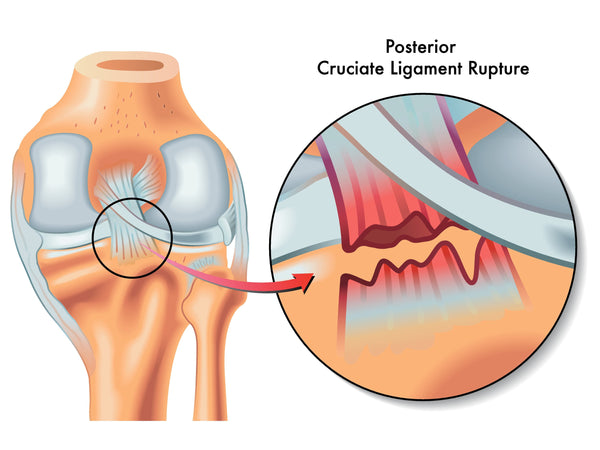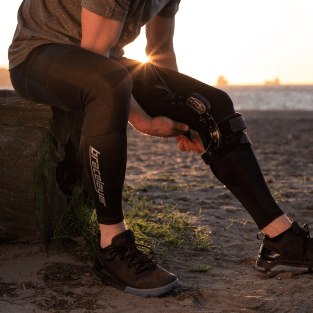What is a Dashboard Knee Injury? How Does It Affect the PCL?

Dashboard Injuries — They Don’t Just Happen in Auto Accidents
A dashboard injury is a type of posterior cruciate ligament (PCL) injury that often happens in automobile accidents, but may also occur during sporting activities where speed, impact, and fall risks are involved. Such sports include, but are not limited to, American football, soccer, skiing, and snowboarding.
In fact, it was on the ski hill where I suffered my PCL injury. I was skiing on Blackcomb Glacier in Whistler, BC one foggy morning when I caught an edge, dropped a ski, and took a tumble. It could have been a fairly painless fall, but I slammed the top of my shinbone into some exposed rock during the process. I immediately felt pain and pressure inside my right knee. I rested for a few minutes, hoping these new knee sensations would subside... but they didn’t. At this point, I realized my ski day (and maybe the whole ski season) was over, so I gingerly proceeded to the base of the mountain.
This was the first time I had injured my right knee, but I was no stranger to knee problems. At 15, I had suffered a complete tear to my left anterior cruciate ligament (ACL). I had three unsuccessful ACL reconstructions on my left knee at 16, 19, and 30 years old. During the third ACL reconstruction, they used hamstring tendon from my right leg, which was uninjured at the time, but my surgeons had already used hamstring and patellar tendon from the left knee during previous surgeries.
At the same time, my surgeons also performed an opening wedge high tibial osteotomy to realign my joint and provide some osteoarthritis (OA) pain relief. This procedure involved removing a wedge-shaped disc of pelvic bone. The top of the shinbone (or high tibia plateau) is then sawed in half, and the wedge of pelvic bone was strategically inserted to re-align the knee joint.
Bracelayer® Knee Stabilizing Compression Pants feature built-in neoprene knee sleeves to relieve knee pain and provide joint support.
I knew that this new ski injury wasn’t the same as my previous ACL tear. The pain, swelling, and instability were less severe. There also seemed to be a dent below the knee, which I had never seen on my other leg. And there was an unfamiliar pressure inside the knee that was different than what I experienced with the ACL injury — a pressure that made kneeling impossible.
After doing some Google “research” back at the cabin, I had a feeling that I might have experienced a PCL injury. This was later confirmed by my doctor — and by the divot in my patellar tendon, which is still present today.
The PCL Helps to Stop the Backward Motion of the Shinbone
The unusual term “dashboard knee injury” refers to an injury of the PCL, or posterior cruciate ligament, which is one of the major ligaments found in the human knee. This type of injury occurs when the victim’s bent knee and shinbone is slammed into an object, like a vehicle's dashboard, with force. This action strains or creates a tear in the PCL. Looking back on my fall while skiing, I do recall my knee being bent when I hit the exposed rock.
The PCL lies deep within the knee and gets its name because it attaches the posterior, or back, of the tibia to the femur. This configuration helps the PCL resist the backward motion of the lower leg or tibia. Together with the ACL and MCL (medial collateral ligament), the PCL helps to stabilize the knee joint. The PCL is a large ligament, much larger than the ACL, and therefore it does take a considerable amount of force to injure it.

Posterior view of a torn PCL / back of right knee.
Don’t Slam the Shinbone!
As mentioned, a "dashboard" PCL injury can occur when the knee is bent and the upper tibia suffers direct impact, causing the shinbone to be pushed backwards below the knee. With enough force, this can result in a tear or rupture of the PCL. While this type of injury is named because of how often it occurs as the result of a car accident, it is also common in high speed and high impact sports such as soccer and American football. Dashboard type injuries can occur during these sporting activities when an athlete falls or is tackled on a bent knee or when there is a collision between players.
PCL injuries can vary dramatically in the degree of damage inflicted. Minor injuries are often difficult to assess and diagnose, and more serious cases show immediate and obvious signs of physical injury and severe knee instabilities.
What are the Symptoms of a Posterior Cruciate Ligament (PCL) Injury?
Internal knee pain and inflammation are the main symptoms of most knee injuries, and a dashboard knee injury is no different. Although, a unique indicator of a PCL injury is a new divot or "dent" in the subject’s patella tendon when the knee is bent. A healthy PCL will stop the backward motion of the tibia, but an injured PCL will allow the tibia to move backwards. This is what causes the dent below the knee.
A posterior sag test can help confirm whether PCL damage exists or not. The test is performed as the subject lays flat on their back and lifts the injured leg in the air, flexed at a 90-degree angle. A positive sign of injury will result in the posterior sag of the tibia and an indent in the patella tendon caused by the pull of gravity.
What Does a Torn Knee Ligament Feel Like?
A ligament tear in your knee will often result in acute pain, swelling in the joint, and bruising. With a PCL injury, your knee may feel looser as the swelling begins to subside. There is also often discomfort, pain, and "pressure" in the joint when kneeling on a knee with a PCL injury. Even simple movements like taking one's shoes can cause discomfort and pain to a torn posterior cruciate ligament. This was especially true for me. I could not pull anything off my foot without experiencing pain. I would loosen shoe and boot laces as much as possible, and then flex my bent leg as I pulled the footwear off, which helped to limit the discomfort in my knee.
PCL Rehabilitation Aims to Achieve Full Return of Strength and ROM of the Knee
The protocol for the rehabilitation of a PCL injury will depend on the degree of damage and whether surgery is recommended or not. Frequently, rehab is often recommended over surgery with PCL injuries, but as always, one should consult the advice of a medical professional. Luckily, PCL injuries are less common and usually less of a hindrance than a severe injury to the ACL. After the lack of success that I had experienced with my ACL surgeries, I didn’t even consider elective knee surgery and instead opted for non-surgical rehab.

As shown in the diagram above, the PCL is an extremely large and strong ligament, and therefore a lot of force is required to rupture it completely. It is 1.5 to 2 times the size of the more commonly injured and discussed anterior cruciate ligament or ACL.
Rehabilitation protocol for non-operative PCL injuries will generally involve the 5-step ‘PRICE’ process common in treating joint injuries: Protection, Rest, Ice, Compression, and Elevation. The next phases of the rehab process focus on restoring patellar mobility, the gradual improvement of extension and flexion of the knee joint, and pain management until full ROM and strength recovery is achieved.
How Long Does a PCL injury Take to Heal?
It takes approximately three months for the swelling and pain of a non-surgical PCL injury to subside. With the right amount of PCL rehabilitation, a full return to active sports may be possible. In cases where surgical intervention is needed, such as a PCL reconstruction, the healing time with rehabilitation is generally in the nine to 12-month range.
After my injury, I took a full month off skiing. I probably should have stayed off it longer, but as we all know, that's easier said than done. I continued to feel discomfort in that knee for the rest of the ski season. I opted for non-surgical rehab and roughly five years later, I rarely have any pain or discomfort in that knee. Although, it is a little less stable than before the PCL strain, and that divot below the knee is here to stay.
Injury Prevention and Automated Cars?
The rise of self-driving cars will almost certainly curtail the frequency of “dashboard” injuries in years to come. Maybe in the not-too-distant future, they will simply be called “bent knee” PCL injuries. But even if that day arrives, we will still be dealing with PCL injures in sport. Like most sports injuries, especially those to the knees, preventive measures can and should be taken to reduce the likelihood of a PCL tear. One should keep the key knee stabilizing muscles of leg in shape, make sure to warm and stretch adequately before activity and give you extra knee support when possible.



























This blog clearly explains dashboard knee injuries with helpful insights and prevention tips. Informative, well-written, and easy to understand, a great resource for anyone learning about knee health.
Leave a comment